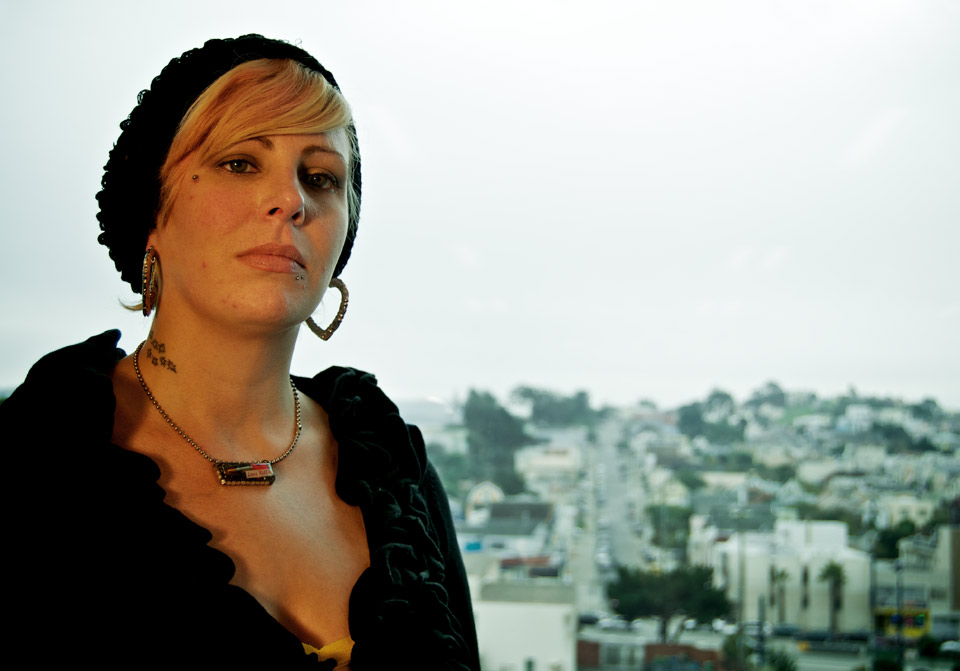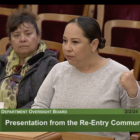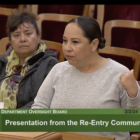By the time Sunshine Schmidt was 19, her rebellious streak led her to prison in Wisconsin for violating probation on a forgery charge. But it was just the beginning of her troubled young adulthood. As she tells it, the uncaring reaction from a criminal justice system on autopilot put her back in prison for minor violations, only driving her further into the life of small-time crime as she racked up drug and theft-related charges.
“Every time, I was released back into homelessness or an abusive partner,” she said. “I didn’t have the resources or tools to get back on my feet.”
It was only three years ago, after leaving a California prison at age 27, that Schmidt was able to pursue legitimate jobs and an education. After living in transitional housing, she became a client of Way-Pass, a City College of San Francisco-based nonprofit organization that helps female ex-prison inmates adjust to everyday life.
But young women in Schmidt’s situation now may have a harder time getting on their feet. Leaders of re-entry programs in San Francisco say state budget cuts in 2010 drastically reduced their ability to help parolees.
Collectively, California’s prison rehabilitation programs took a nearly 45 percent cut — $250 million — in fiscal year 2009-10 as legislators and the governor grappled with the state’s budget crisis.
The 2010-11 budget, passed in October after a 100-day delay, cuts $1.1 billion from the California Department of Corrections and Rehabilitation. State officials said they expected most of this to come from staff cuts, reductions in medical care and early release of prisoners. The previous year’s cuts are not expected to be reversed anytime soon.
Way-Pass lost two of its four paid positions and no longer has funds to provide scholarships, schoolbooks or cash stipends to clients.
Karen Shain, policy adviser at Legal Services for Prisoners with Children, said life in California’s female prisons is worse than ever. The reduction in education and drug treatment programs has led to violence and unrest.
The female prison population soared eightfold nationwide between 1977 and 2007, double the rate of increase for men. Mounting evidence points to economic factors, addiction and abuse as the primary causes of criminal behavior among women. Women respond much better to rehabilitation and drug treatment programs than men do, according to a corrections department study.
Schmidt said programs such as the California Coalition for Women Prisoners and City College’s Second Chance Program, both operated by and for the formerly incarcerated, are particularly effective. “We empower each other to lift each other up,” Schmidt said.
Women in prison struggle with issues distinct from those affecting men, including reuniting with parents and children, sexual abuse and trauma, gender-specific health needs and the social stigma of a felony record, said Edith Guillén-Núñez, an adviser to the Way-Pass program. But because 90 percent of released prisoners are male, many rehabilitation programs target men only.
FRAYING NETWORK OF SERVICES
“That cut happened essentially overnight,” said Vitka Eisen, the nonprofit group’s chief executive officer. They were given little more than a month to prepare for a major decrease of staff and services at the beginning of 2010.
Walden House offers rehabilitation for substance abuse, domestic violence, sexual trauma, mental health services and family reunification at locations scattered around San Francisco. The organization also offers treatment inside prisons throughout California.
Valley State Prison for Women in Chowchilla and the adjacent Central California Women’s Facility together house most of the state’s 10,000 female prisoners and are often mentioned as the world’s most populous women’s prison complex.
Walden House this year had to reduce the number of women it serves in these prisons by more than 75 percent. “There were 750 women that we saw in the Central Valley,” Eisen said. “Now we have 175.”
The last year and a half also saw the San Francisco treatment centers downsize to 427 employees from 689 last year. Of those, 125 were laid off one day in January.
FAILED REFORM EFFORTS
A state law that had made the transition out of prison easier for offenders with drug problems was undermined by another bill three years later.
Senate Bill 1453, introduced by then-state Sen. Jackie Speier in 2006, allowed prisoners to reduce their sentence by one day for every two days spent in drug treatment in prison, provided that they also completed 150 days of an “aftercare” program upon release.
When Schmidt got out of prison, this law mandated her release to Walden House, where she completed a four-month residential treatment program.
Parolees were guaranteed a spot in a treatment program and a place to stay, rather than being given a phone number, a bus ticket and a “good luck getting in.”
“That was huge,” Schmidt said. “They would actually transport you to the program.”
But this year, on top of the budget cuts, another reform added to the complications for programs offering rehabilitation to women. State Sen. Denise Ducheny’s SB 18 implemented a non-revocable parole policy in January. Those who qualify are, in effect, on parole in name only. They have no parole officers and no drug tests, and can’t violate their terms of parole. Any new offenses are treated as crimes, not parole violations.
California enacted SB 18 to comply with a federal mandate to reduce the state’s prison population to 137 percent of design capacity by 2012. Prisons have nearly double the number of inmates they were built to contain. This order is being contested before the U.S. Supreme Court.
Eisen said the reform is a step forward because it spares people from returning to prison repeatedly for minor offenses. At 70 percent, California has the highest recidivism rate in the country.
But those who have not committed sexual, violent or serious felonies, and who would be aided by the support services and early release that SB 1453 provides also qualify for non-revocable parole. This “unsupervised community release” blocks access to services provided by the parole system, such as housing, education funding and job opportunities.
CUTTING TIES TO CRIME
Schmidt’s story testifies to a system designed for punishment, not necessarily rehabilitation.
When Schmidt turned 12, she took her birthday money and ran away from home in a Wisconsin suburb. She wasn’t having any real trouble at home, but her best friend had an abusive step-father, so they took an early jump at independence.
Schmidt didn’t think it amounted to much at the time. She was just rebelling. Her mother felt differently. After she was picked up by the police and returned home, she was placed in a mental institution.
“I’ve been going through the incarceration system my whole life,” Schmidt said. “I was institutionalized in one form or another from a young age.”
At age 24, having been in and out of prison in Wisconsin, she moved to San Francisco, looking for a fresh start. Her only job experience as an adult was doing make-up in a Wisconsin beauty shop. She applied for jobs at local department stores with no success.
Unable to find work, she sold drugs again to pay her rent. One offense led to another, she got evicted, went to jail a few times, then found herself homeless and pregnant on the streets of San Francisco. In 2007, she lost custody of her 2-year-old daughter the day before her release from Valley State Prison for Women.
Schmidt knows from experience and from talking to people on both sides of the walls that once you’re in the system, it can be very difficult to get out.
Upon release, Central Valley prisons’ female inmates without family to pick them up receive $200, a pair of flip-flops and a muumuu. The downtown Fresno bus station is said to be crawling with pimps and drug dealers on the lookout for those cheap, flowered dresses.
“They’re going to do what’s comfortable and what they know,” Schmidt said. “A lot of people end up right back in the system.”
For her, the turning point was access to treatment programs, and a place to stay once she was free.
Way-Pass offered her case management, peer counseling and referral services for clothing, food vouchers, health care and housing. Schmidt is now a case manager there.
She is getting A’s in school as she counsels other formerly incarcerated women and works toward a bachelor’s degree in legal studies or public policy. She wants to work to change legislation regarding incarceration.
When she has time to talk between five classes and her jobs at the college and an environmental non-profit, she speaks somberly about her experiences and the challenges facing incarcerated women. Though talking about these things is part of her job and her studies, it never gets easy, she said.
A version of this article was published in the fall 2010 edition of the San Francisco Public Press newspaper. Read select stories online, or buy a copy.










